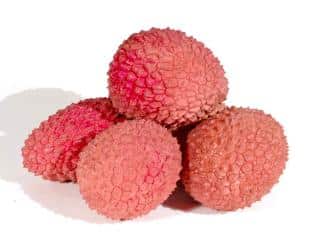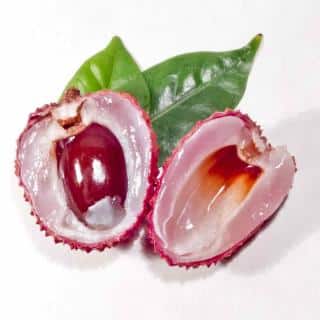

Lychee or Litchi chinensis is a fruit with many benefits that are good for health.
They belong to the Sapindaceae family. This fruit tree is native to China, hence its nickname “Chinese cherry tree”. In its native environment, warm and moist, this tree can reach up to 65 feet (20 meters).
This uncommon fruit with a round shape, sweet white flesh and pinkish peel is available only from November to January.
There are many lychee varieties, but only very few appear on our local supermarket stalls.
Lychee is beloved both for its exotic taste and for its beneficial properties for health and beauty.
China has been growing lychee for over 2000 years before our era. A symbol of joy, lychee was offered as a gift to Emperors. In olden days, lychee was already used for its analgesic properties.
This exotic fruit arrived in Europe during the 18th century and then spread to those countries’ colonies (Madagascar, Reunion), where it is grown until today.
Lychee offers a bounty of beneficial properties.
 First of all, lychee soothes pain. It is an effective analgesic in case of headaches and gastric pain.
First of all, lychee soothes pain. It is an effective analgesic in case of headaches and gastric pain.
Like most fruits, lychee has high fiber content: 1.5 g for 3.5 oz (100g). It regulates intestinal transit and improves digestion. Thus lychee is a remedy for constipation and it soothes pain and heartburn. It is ideal to put order back in our digestive functions, especially after the load it endures during end-of-year celebrations.
Lychee is an rich source of antioxidants. These neutralize free radicals, which are detrimental to our health and responsible for various cancers and other diseases.
The first among these antioxidants is of course vitamin C, involved in defending the immune system. It stimulates our defense protocols when faced with certain pathogens (viral agents especially).
Lychee reduces bad cholesterol levels and limits build-up of it in the arteries.
Moreover, it provides potassium, the most essential ion in the intracellular medium. It is a key helper for heart contractions and thus regulate arterial blood pressure. As a consequence, lychee reduces the risk of developing cardiovascular diseases and diabetes.
Ingestion: the amount to drink would be one glass of lychee juice a day.
This exotic fruit offers a very reasonable 66 kcal / 3.5 oz (100 g). Lychee thus finds a place in a healthy diet. Of course, you shouldn’t overdo it.
Athletes love it because lychee enhances muscle tone. Also, it is very effective to stimulate you in case of fatigue. It is also often a good suggestion for pregnant women.
Lychee contains B group vitamins, too. These are involved in reducing cholesterol levels and in producing erythrocytes (red blood cells that carry oxygen).
It also contains many minerals and trace elements crucial in enabling proper body functions. This includes elements such as calcium for bone and tooth health, iron against anemia, as well as sodium, phosphorus and magnesium.
 Lychee is actually 80% water. It provides ½ oz (15 g) carbohydrates and no fats at all.
Lychee is actually 80% water. It provides ½ oz (15 g) carbohydrates and no fats at all.
Lychee can equally be eaten raw or cooked, sweet or salty.
In a mixed fruit salad, lychee will provide a touch of exotic taste. It is delicious when cooked together with coconut or grapefruit.
At the same time, blend it to make ice cream, add it to cocktails, make jam and why not a mousse or clafoutis?
Lychee flowers, which are white and without any petals, is a basis for bees to make a particularly excellent honey which you will love if you get your hands on it.
Lychee can also fit as a part of main course meals. It fits right in with chicken curry or gambas. And it also is great paired with raw fish.
Lychee and its antioxidant properties watch over proper skin cell regeneration. The fruit nourishes, hydrates and reduces skin wrinkles. It is also beneficial to hair growth.
Winter face mask with lychee – Mix one egg white (or half a banana) with 5 blended lychees. Apply the resulting paste to your face. Rinse after 20 minutes.
For sharper skin without blemishes: Dip your face cotton in lychee juice.
Preserving lychee – A few days at room temperature or one week in the vegetable section of the fridge.
How to open a lychee – wrap the lychee between thumb and forefingers of both hands. Each hand should cover half the fruit with both hands touching at the middle. Twist hands in opposite directions to pop the fruit open! There’s a large pit inside, so don’t take a large bite.
Did you know? Rambutan, also called “hairy lychee”, also belongs to the Sapindaceae family. However, it isn’t the same species as lychee and they can’t cross-breed, even though they look alike.
Hi! Do you know if you get these same benefits from the syrupy preserved lychee bought in cans at the supermarket?
Hi Cheska, you’ll get the fiber advantages, all the mineral nutrients, and some of the vitamins, but not as much for sure. These fruits are sometimes pasteurized and cooked in sugar for a while during the canning process, I doubt there are as many health benefits left compared to eating the fruits fresh!